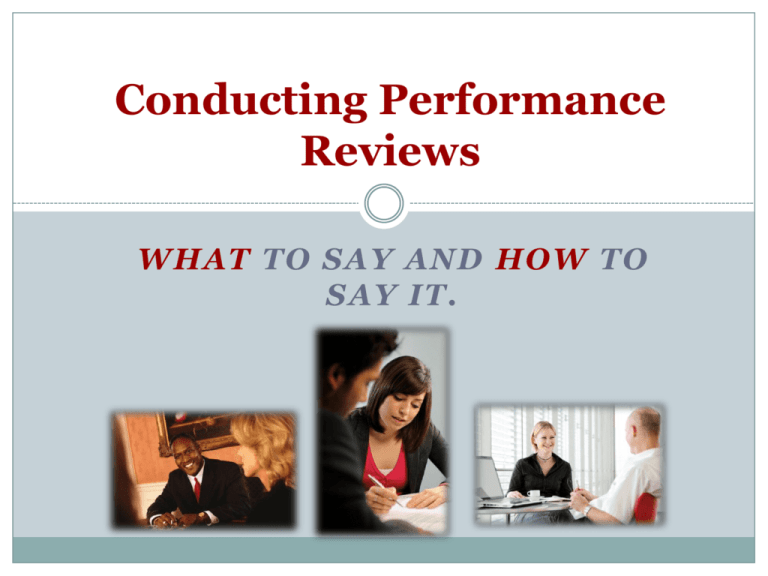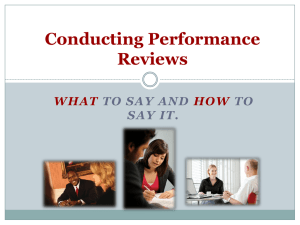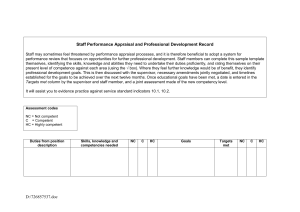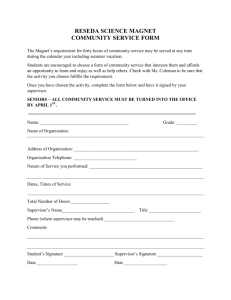EFFECTIVE EMPLOYEE APPRAISALS
advertisement

Conducting Performance Reviews WHAT TO SAY AND HOW TO SAY IT. What Happens in Mid-Year Reviews . . . THE PROBLEM WITH REVIEWS According to Supervisors. . Employees say. . . Take too long to write. Never get one or it’s late. People only want good news. All checkmarks and no It’s about “Show me the examples. No guidance about what to do differently. No link between performance and pay. money!” Don’t improve performance. What do you want to know? REINFORCE EXPECTATIONS Why Conduct Performance Reviews? • Opportunity for formal written feedback and dialogue about development. • Emphasize a “performance” culture. • Reinforce expectations & recognize achievement of them. • Generate documentation and a record (+ and -). • Justification for employment decisions. Performance management should clarify: What is expected of me? Why is it important? How am I doing? Performance Management vs. Performance Review Set Goals July Review Meeting May Cascade Goals Upward Ongoing Feedback Self Assess Manager Assess April Mid Year Review November Performance Management Continuous interaction Part of the ongoing “routine” Ongoing development Observations with feedback for small incremental changes “Real-time” here-and-now orientation COACHING Performance Review Singular meeting (2x’s/yr) “Dedicated” time Development “plan” Summarizes results against expectations Documentation of past events SUMMARY EVALUATION Purpose of Performance Reviews GIVING Feedback Engagement Regarding performance & development RECEIVING Feedback Preparing for the Appraisal Session “Before you rob your first bank, knock off a couple of gas stations.” * -John Dillinger Schedule in advance. Allow 15-45 minutes. Review your comments. Notes. Have examples. May have samples. Ideas for needed adjustments. Start with best performers (?)* OPTIONS ??? •Top/Valuable Performers: Send forward/give copy ahead of time. •Developing/Require Improvement Performers: Wait until face-to-face. •Hand a copy to the person and walk them through it. •Sit side-by-side and review one document together. Review Meeting Supervisor summarizes ‘core message.’ Staff member listens, responds, thanks supervisor for feedback. Summary Staff member and Supervisor discuss career interests & development activities. Development Discussion Staff member arrives open-minded. Supervisor describes process & invites self-assessment. Opening SelfAssessment Supervisory Comments Staff comments on selfassessment & gives examples. Supervisor asks clarifying questions. Supervisor identifies areas of agreement with own examples; provides rationale & examples to explain differences. Questions, validate and listen. Staff responds/asks questions to clarify. Conducting the Appraisal Session No interruptions! Open, pleasant atmosphere. Opening: Purpose, Process, Mutual Self-Assessment Ask, “What achievement are you most proud of?” Or, “What did you do that made a difference?” And, “What did you learn this year?” Your Appraisal Explain each rating & provide examples Areas of agreement Areas of differences Invite questions/conversation Discuss development needs & career plans Summarize & send the ‘Core Message” (The main message you want them to remember three months from now.) Express confidence and thank the person Be Descriptive and Have Examples! Goals/Expectations Factual quality-quantity-date information that directly supports the level of attainment Description of specific related activities; references to a work sample, project, incident Behavioral Competencies Specific examples that show obvious connection to each competency. Incorporate phrases from Appraisal Wizard along with a specific incident involving you. Overall Comments General summary regarding the level of performance Reiteration of key positive highlights/ progress achieved May contain “Core Message” Challenging Reactions Significant difference in your rating vs. employee’s Defensive or argumentative Hurt “Don’t care” attitude Handling the Reaction Hostile/Resistance/Denial Indifference Do: provide examples, Do: ask them to reflect ask them to reflect and get back to you, explain impact of not addressing Don’t: get aggravated, change your evaluation, attack the person and confirm that they are committed to improving, discuss consequences Don’t: overlook the indifference, lose patience, interpret as apathy Handling the Reaction Lack of Confidence/Selfpity Responsibility Skirting Do: allow time to gain Do: listen to their composure, highlight the opportunity, reassure and support, suggests small steps toward improving Don’t: rehash the past, moderate the feedback, join in the pity party perspective, restate examples, clarify the expectations going forward Don’t: agree with the employee blaming others, change your perspective Handling the Reaction Shock and Anger All Cases Do: acknowledge that Do: refer to EAP if the they are not happy with the feedback, ask for their comments, restate examples Don’t: attack the person for being angry, get defensive, change your feedback reaction is significant and/or does not moderate with time Using Open Ended Questions/Statements Tell me more about that. I’m curious, why do you say this? Given the results this year, what would you like to see happen next year? How would you like to proceed with this opportunity? What worked well in the past? How can you use that experience in this situation? Validation It’s clear you are upset, it’s perfectly understandable. The anger in your voice is clear, anyone would be feeling this way in this situation. You’re reaction is understandable. The point you are making is clear and it makes perfect sense that you see it this way. You seem pleased with your results and you have every right to be. Fishbowl PERFORMANCE LEVELS TOP Exceeds expectations in most aspects of the job frequently. Goes above and beyond what is asked. Thinks ahead. Is proactive. Seeks improvement. Solves problems independently. VALUED DEVELOPING Meets expectations in all major aspects of the position and exceeds some. Sometimes goes beyond what is asked. Takes initiative to solve problems. Seeks learning and improvement. New to the position or some duties are new. More training/learning is needed to be fully performing all aspects of the job at the desired level. Performance does not meet expectations for fully experienced person. REQUIRES IMPROVEMENT Regularly fails to meet established standards/goals. Lacks required skills, knowledge, willingness or capability to perform. Fails to recognize effect on others and or does not make necessary changes when advised of the need. Not consistent with Core values. Immediate and sustained improvement required. CORE MESSAGE: The Last Word! Plan your CORE MESSAGE so they know: To what degree they met the goals/expectations. One area/item they can enhance (learn, improve, change). A major strength, area of potential or significant contribution.





